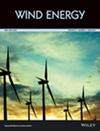Impact of turbulence and blade surface degradation on the annual energy production of small‐scale wind turbines
IF 3.3
3区 工程技术
Q3 ENERGY & FUELS
引用次数: 0
Abstract
Abstract Small‐scale horizontal axis wind‐turbines (SHAWTs) are acquiring relevance within the regulatory policies of the wind sector aiming at net‐zero emissions, while reducing visual and environmental impact by means of distributed grids. SHAWTs operate transitionally, at Reynolds numbers that fall between . Furthermore, environmental turbulence and roughness affect the energetic outcome of the turbines. In this study, the combined effect of turbulence and roughness is analysed via wind tunnel experiments upon a transitionally operating NACA0021 airfoil. The combined effects cause a negative synergy, inducing higher drops in lift and efficiency values than when considering the perturbing agents individually. Besides, such losses are Reynolds‐dependent, with higher numbers increasing the difference between clean and real configurations, reaching efficiency decrements above 60% in the worst‐case scenario. Thus, these experimental measurements are employed for obtaining the power curves and estimating the annual energy production (AEP) of a 7.8‐kW‐rated SHAWT design by means of a BEM code. The simulations show a worst‐case scenario in which the AEP reduces above 70% when compared to the baseline configuration, with such a loss getting attenuated when a pitch‐regulated control is assumed. These results highlight the relevance of performing tests that consider the joint effect of turbulence and roughness.湍流和叶片表面退化对小型风力发电机年发电量的影响
小型水平轴风力涡轮机(shawt)正在风电行业的监管政策中获得相关性,旨在实现净零排放,同时通过分布式电网减少视觉和环境影响。shawt的工作是过渡的,雷诺数介于两者之间。此外,环境湍流和粗糙度影响涡轮的能量输出。在本研究中,湍流和粗糙度的综合影响进行了分析,通过风洞实验在过渡操作的NACA0021翼型。综合作用会产生负协同作用,与单独考虑干扰剂相比,会导致更大的升力和效率值下降。此外,这些损失与雷诺数有关,较高的数值会增加清洁配置与实际配置之间的差异,在最坏的情况下,效率会下降60%以上。因此,这些实验测量被用于获得功率曲线,并通过BEM代码估计7.8 kW额定SHAWT设计的年发电量(AEP)。模拟显示了最坏的情况,与基线配置相比,AEP降低了70%以上,当假设螺距调节控制时,这种损失得到衰减。这些结果突出了进行考虑湍流和粗糙度联合效应的测试的相关性。
本文章由计算机程序翻译,如有差异,请以英文原文为准。
求助全文
约1分钟内获得全文
求助全文
来源期刊

Wind Energy
工程技术-工程:机械
CiteScore
9.60
自引率
7.30%
发文量
0
审稿时长
6 months
期刊介绍:
Wind Energy offers a major forum for the reporting of advances in this rapidly developing technology with the goal of realising the world-wide potential to harness clean energy from land-based and offshore wind. The journal aims to reach all those with an interest in this field from academic research, industrial development through to applications, including individual wind turbines and components, wind farms and integration of wind power plants. Contributions across the spectrum of scientific and engineering disciplines concerned with the advancement of wind power capture, conversion, integration and utilisation technologies are essential features of the journal.
 求助内容:
求助内容: 应助结果提醒方式:
应助结果提醒方式:


